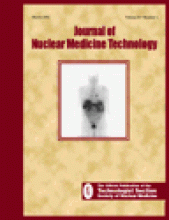Andrew Taylor, David M. Schuster, Naomi Alazracki. Reston, VA: Society of Nuclear Medicine, Inc.; 2000; 400 pages; $45, hardcover.
The authors of A Clinician’s Guide to Nuclear Medicine have provided a concise and practical handbook written specifically for physicians taking care of patients. This is a well-constructed book providing clear clinical diagnostic guidelines; it would be a valuable text to have available in any diagnostic library. Drs. Taylor, Schuster, and Alazracki have accomplished their goal of providing the clinician with a readable guide that provides practical answers to the use of nuclear medicine procedures, both diagnostic and therapeutic.
For technologists, this reference reminds us why we are here, with explanations of how nuclear medicine can aid in the diagnosis and treatment of disease. Brief descriptions of the tests available in nuclear medicine are presented along with their advantages and limitations. Also, alternative tests are discussed and compared with nuclear medicine procedures. Patient preparation, including special diet, medication, and hydration requirements are presented in summary.
The book is organized by clinical chapters, or organ systems, for easy reference. After a brief introduction, each chapter contains a practical outline of “Scans and Primary Clinical Indications,” “Clinical Questions,” and “Patient Information.” These are cross-referenced by page number. Chapters are further subdivided into these sections: “Scans,” “Clinical Questions,” “Worth Mentioning,” and “Patient Information.” The “Scan” section covers a brief clinical background, radiopharmaceuticals used, how the study is performed (concisely), patient preparation, understanding the report (clinically focused), and potential problems. “Clinical Questions” discusses the advantages and limitations of nuclear medicine procedures, and “Worth Mentioning” looks at new areas of research that may become important in the future. “Patient Information” provides a summary, written for the patient, that outlines the test procedure, radiation risks, and special requirements for most common studies. The authors specifically state that these summaries may be copied from the book, reviewed by the nuclear medicine practitioner, and given to patients. Patient summaries for therapeutic procedures are rare because of the need for individualization; patient summaries for low-volume studies are excluded. References are included at the end of each chapter. The final chapter contains a discussion and table of comparative costs of diagnostic procedures in terms of 1999 Medicare reimbursements. A standard index concludes this reference guide.
Clinical chapters are arranged from cardiovascular disease to various cancers. Because many nuclear medicine departments perform a significant number of cardiac procedures, cardiac imaging generates much interest. Chapters progress from cardiovascular to pulmonary, genitourinary, and hepatobiliary systems. Gastrointestinal imaging covers gastrointestinal (GI) bleed and gastric motility studies. Chapter 6 gives a very practical approach to infection imaging; the clinical questions presented are helpful in imaging various infectious disease states. This eliminates some confusion of study choice. Nuclear imaging’s role in the diagnosis and treatment of AIDS using thallium and gallium scans is outlined briefly. Brain imaging, with the recent incorporation of coincidence detection equipment and availability of new radiopharmaceuticals, is presented as a powerful but underused diagnostic tool. Nuclear scans have long been used to diagnose thyroid disorders; chapters devoted to thyroid and parathyroid imaging provide the answers to practical clinical questions. Bone imaging is discussed as it relates to neoplasia, bone pain, trauma, bone viability, and systemic diseases. Estimation of fracture risk using bone density measurements is presented as well as screening suggestions for osteoporosis. Also included is an informative chapter devoted to women’s health that outlines coronary artery disease and diagnosis and staging of breast cancer.
The second half of the book focuses on the role of nuclear medicine in the management of the most common types of cancers. Neuroendocrine tumors, lymphoma, lung cancer, melanoma, breast, colorectal, ovarian, prostate, and thyroid cancers are outlined in brief chapters with discussions of initial evaluation, staging, and therapy considerations.
Technical content is brief; the book does not attempt to provide complicated answers to how studies are performed. However, in each “Scan” section, a paragraph or two is written to cover the basics with the interest of the clinician in mind. Most chapters provide a few images for reference. These are accompanied by practical explanations of the scan type and clinical diagnosis. The authors’ descriptions are adequate and informative without being overwhelming.
Flow charts are provided for clinical situations such as GI bleed and pulmonary embolism. This real-life approach increases the reader’s practical understanding of these diagnostic puzzles.
The authors’ “Worth Mentioning” sections of each chapter are particularly of interest to the nuclear medicine professional. The book briefly mentions new procedures and radiopharmaceuticals, such as NeoTect (Berlex Laboratories, Richmond, CA) (99mTc-labeled somatostatin analog) in these areas. Indications are given as to what may soon appear in imaging literature.
In summary, I would strongly recommend this book as a practical guide to the use of clinical nuclear medicine. For technologists, this book provides important, easily understood information, outlined by organ system, on the way nuclear medicine is used to aid in the diagnosis of disease. The book has a compact, readable format that lends itself for use as a valuable teaching tool. How about a pocket version for the referral base?







